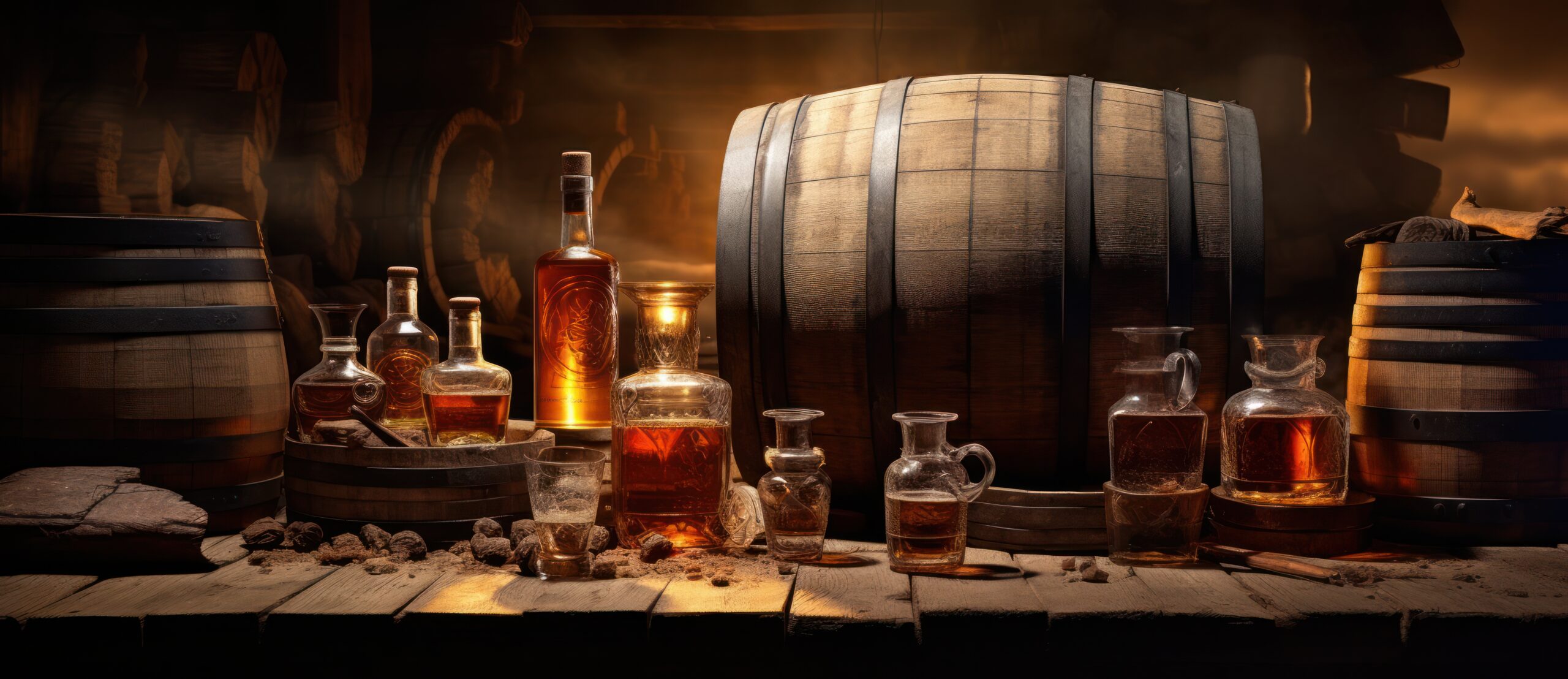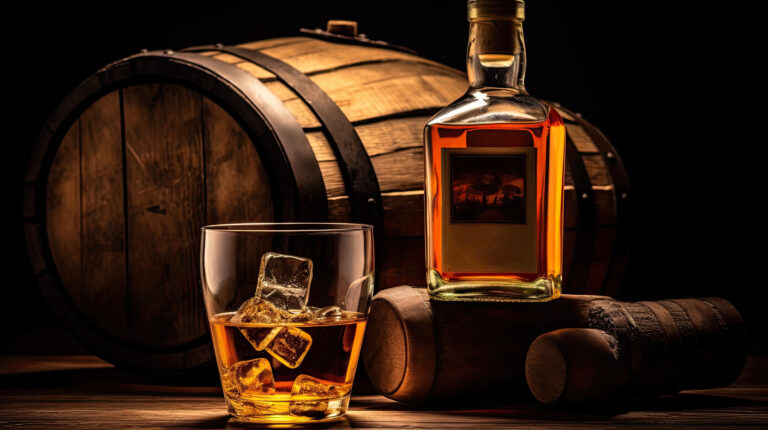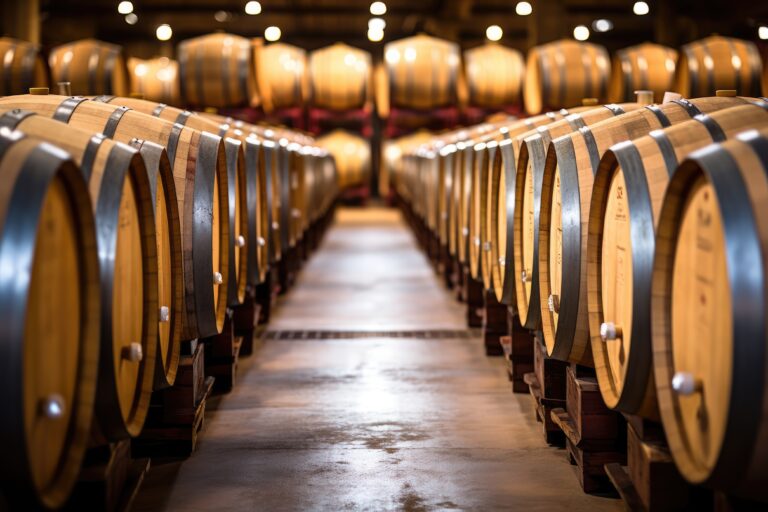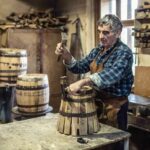It’s truly fascinating, isn’t it? Have you ever paused to wonder what transforms whiskey into that wonderfully complex symphony of flavors we all adore? The secret, my friend, lies in the magical barrel aging process. Just like a fine wine mellows and deepens with time, whiskey undergoes a similar, yet distinct, metamorphosis. But here’s the twist: distillers don’t just use oak barrels for mere storage; they artfully harness the very essence of the wood to weave in those distinctive aromas and tastes. It’s where the raw spirit truly comes alive!
The moment that golden liquid kisses the inside of a whiskey barrel, the enchanting infusion process kicks off. Compounds nestled within the wood begin their delicate dance, breaking down and dissolving into the spirit, shifting its chemistry in truly captivating ways. Think of it: the whiskey literally sips up delightful flavors from the wood – hints of luscious vanilla, warm caramel, and intriguing spice. All the while, oxygen, ever so gently, breathes into the barrel, patiently mellowing the whiskey’s harsh edges, turning a fiery spirit into a smooth, delightful experience.
This whole barrel aging journey is nothing short of an art form. Distillers, like true maestros, meticulously select and prepare their whiskey barrels, crafting the perfect environment for flavor to blossom. Every detail matters: the wood variety, the degree of barrel char, and even the aging location – each plays a pivotal role in shaping the final liquid gold. After years of patient anticipation, the distiller gets to savor the fruits of their labor, witnessing how their craft has been transformed into a complex, nuanced elixir. And here’s the beauty of it: no two whiskey barrels are ever quite the same, meaning each batch of barrel-aged whiskey embraces a unique character, a personality all its own.
The Chemistry of Whiskey Barrel Aging: Unlocking Flavor Secrets
At its core, the whiskey aging process is where the spirit truly develops its signature flavor and aroma compounds. As that fiery liquid matures in charred oak barrels, a complex ballet of chemical reactions unfolds between the spirit and the wood. It’s like a slow, deliberate conversation that builds incredible depth.
The Barrel’s Profound Impact on Whiskey Flavor
The type of whiskey barrel used – typically robust American white oak or elegantly charred European oak casks – wields immense power over the final flavor profile. Ever noticed those intriguing notes in a particular dram? Often, it’s thanks to barrels previously cradling wine, Sherry, or Port, imparting subtle echoes from their past lives. And it’s not just the wood type; barrel size and char level are crucial too. Think about it: more surface area and a heavier char often lead to faster aging and even richer, bolder flavors. It’s all about surface contact and how the wood interacts with the spirit.
Evaporation: The “Angel’s Share” Concentrates Flavor
As whiskey gracefully ages, a bit of the liquid – both water and ethanol – mysteriously evaporates through the porous barrel. This phenomenon, affectionately known as the “angel’s share,” actually works to concentrate those wonderful flavor and aroma compounds. Intriguingly, this loss of ethanol also means that the ABV (alcohol by volume) gently decreases over time. What’s left behind in the barrel boasts a higher concentration of congeners – those delightful flavor molecules like the sweet vanillin, creamy lactones, and even the subtle grip of tannins from the wood, alongside the fruity esters from the original distillate. It’s like the good stuff just gets more intense!
Oxidation and Esters: Crafting New Flavors
Here’s another secret ingredient: oxygen. It subtly seeps into the barrel through the wood, slowly but surely oxidizing the whiskey. This gentle oxidation works wonders, mellowing harsh flavors and creating lovely, fruity esters. Imagine esters like ethyl acetate forming from the interplay of ethanol and acetic acid, bestowing notes of ripe fruit and contributing to that wonderfully smooth, rounded quality. And those intriguing oak lactones? They’re the ones giving off that delightful coconut aroma we sometimes detect.
The Maillard Reaction: Adding Decadent Depth
The gentle warmth inside the whiskey barrel creates the perfect conditions for a truly magical transformation: the Maillard reaction. This fascinating chemical dance between amino acids and reducing sugars conjures up a whole symphony of flavor molecules, giving us those irresistible aromas of luscious caramel, buttery toffee, and sweet butterscotch. These rich, indulgent notes are what truly provide that incredible depth and complexity to a well-aged whiskey.
It’s this patient march of time in the barrel that allows all these intricate chemical reactions to unfold, meticulously crafting the distinctive aroma, taste, color, and even the mouthfeel of truly fine aged whiskey. Master distillers are like watchful guardians, carefully monitoring each barrel, discerning the precise moment it reaches its peak maturity and flavor. The outcome? A product as intricate and satisfying as any exquisite fine wine.
How Wood Imparts Flavor to Whiskey: A Silent Partnership
When whiskey is nestled in those wooden barrels, the wood itself becomes an active participant, lending its character to the spirit in a couple of captivating ways.
Firstly, the whiskey literally drinks in aromatic compounds from the wood – think delightful notes of vanilla, coconut, and clove. The specific bouquet, of course, hinges on the type of wood used, whether it’s the classic oak, the distinctive hickory, or even the sweeter maple. But oak barrels, especially those with a history of cradling bourbon, are the true superstars, consistently delivering those beloved flavors of vanilla, caramel, and spice.
Secondly, and equally important, the wood itself undergoes a gentle breakdown over time, generously releasing lignin, tannins, and wood sugars into the whiskey. Lignin contributes intriguing notes of clove and a whisper of smoke, while tannins introduce a touch of pleasing bitterness and astringency. The wood sugars, on the flip side, bring a lovely sweetness to the party. It’s the harmonious dance and careful balance of all these wood-derived flavors that ultimately create such incredible depth and complexity.
How Long Does It Take? The Patience of Perfection
The longer a whiskey serenely ages in its barrel, the more it truly absorbs from the wood. A mere few years might impart subtle nuances, but a whiskey aged for 10-30 years develops significantly more intricate flavors from that extended, intimate interaction with the barrel. However, there’s a sweet spot; after a certain point, the wood has generously given all it can, and further aging doesn’t necessarily improve quality, sometimes even leading to over-oaking.
Barrel storage methods are also crucial players in this flavor symphony: the barrel char level, barrel size, the barrel’s precise location within the warehouse, and even the ebb and flow of temperature and humidity all significantly impact how much and what kind of flavors the wood bestows upon the whiskey. Master distillers are like conductors, meticulously controlling all these variables to orchestrate the distinctive flavor profile of their cherished aged spirits.
Ultimately, aging whiskey in wood is a beautiful art form that masterfully blends scientific understanding with intuitive craftsmanship to achieve that harmonious balance between spirit and wood. The result, as any whiskey connoisseur will wholeheartedly agree, is pure flavor alchemy.
Charred vs. Uncharred Barrels: The Art of Toasting Effects
The way a barrel is toasted or charred has an enormous influence on the flavor compounds that flourish in whiskey during its aging journey. Barrels can be charred to varying degrees, from a gentle toast to a deep, heavy char, or even left entirely uncharred.
A light toast generously offers subtle whispers of vanilla and caramel. Just a short kiss from the flame gently chars the wood, creating aromatic compounds that impart a wonderfully mellow, rounded sweetness.
Medium toasts unleash more robust flavors – think creamy coconut, intriguing spice, and even a hint of smoke. The longer exposure to higher heat rapidly accelerates the wood’s breakdown, leading to the creation of more complex compounds.
Heavy charring results in bold, impactful flavors of rich chocolate, dark coffee, and luscious molasses. The dark, beautifully burnt layer of wood left behind after prolonged charring generously infuses the spirit with robust, savory notes.
Uncharred barrels, often crafted from oak, allow the raw, natural flavors of the wood itself to sing – fresh-cut lumber, aromatic cedar, and even crisp pine. Without the char, the interaction between the spirit and the wood is more direct, resulting in a lighter, fresher flavor profile.
The sheer variety of flavors that can emerge during whiskey barrel aging is absolutely astounding! While charring is widely embraced for producing the bold, characteristic flavors we associate with bourbon and Tennessee whiskey, the possibility of experimenting with diverse toasting methods and wood types offers nearly endless avenues for customizing flavor.
Whether you’re savoring the natural simplicity of an uncharred barrel or delving into the rich complexity of a heavily charred one, whiskey lovers can undoubtedly discover a flavor profile that perfectly suits their palate. The true magic of barrel aging lies in witnessing how wood and spirit intertwine to create a whole that is far greater than the sum of its individual parts.
The Importance of Barrel Location in Warehouses: A Hidden Variable
Believe it or not, the precise location of whiskey barrels within a warehouse profoundly influences the flavor compounds that develop as the spirit ages. Barrels tucked away in the upper levels of rickhouses, where temperatures naturally soar, will yield whiskey with more robust flavors in a shorter timeframe.
Higher Heat Means Faster Aging
As heat causes the whiskey to gently expand into the wood, the spirit eagerly absorbs more of the barrel’s distinctive characteristics. The higher the heat, the quicker this fascinating process unfolds. Whiskey aged in barrels residing on the warmer, upper floors of warehouses tends to develop richer, fuller flavors in less time. These barrels often produce whiskey brimming with delightful notes of vanilla, caramel, and spice.
Lower Floors Mean Slower, Subtler Aging
Conversely, barrels patiently resting on lower warehouse levels age more slowly, producing whiskey with lighter, more delicate flavors. The cooler temperatures cause the spirit to expand into the wood at a more leisurely pace. After several years, these barrels generously yield whiskey with subtle whispers of oak, nuts, and dried fruit. This slower aging process allows these nuanced flavors to gracefully emerge over time.
Middle Floor Offers a Harmonious Balance
For whiskey makers seeking that perfect equilibrium between robust and delicate flavors, barrels nestled on the middle floors of the rickhouse offer an ideal compromise. Here, temperatures are moderate, and the aging process unfolds at a steady, consistent pace. After a few years of aging, these barrels produce whiskey with a truly complex blend of oak, caramel, spice, and fruit flavors. The mid-level location truly offers the best of both worlds!
By skillfully controlling barrel location within the warehouse, distillers can craft a remarkable variety of flavor profiles from the very same batch of distilled spirit. The interplay of heat and airflow in different areas of the rickhouse creates distinct aging conditions that uniquely shape the whiskey. So, it’s not just about real estate; for whiskey makers, location, location, location is truly the key to crafting that signature flavor.
American Oak vs. Other Woods for Barrel Making: A World of Flavor
American oak barrels have long been the gold standard for aging whiskey in the U.S. This wonderfully porous, aromatic wood generously imparts those signature flavors like creamy vanilla, sweet caramel, and intriguing spice. But did you know that oak from other corners of the globe can create entirely different flavor profiles?
European oak, a popular choice for Scotch whisky, tends to be more tannic, lending drier, woodier notes. Japanese oak barrels, often used for exquisite Japanese whiskies, produce lighter, more delicate flavors. The famed mizunara oak, in particular, is celebrated for bestowing fragrant sandalwood and even delicate incense aromas.
American Oak: The Undisputed Classic Choice
For bourbon, rye, and most American whiskies, U.S. regulations specifically mandate the use of new charred oak containers. The process of charring these oak barrels before filling them with distillate is crucial; it helps to unleash those wonderful oak lactones that give bourbon its characteristic vanilla sweetness. The porous nature of the wood also facilitates essential oxygenation and evaporation, gracefully mellowing the spirit.
White oak, especially from the Ozarks and Appalachians, is highly prized for crafting whiskey barrels. Its tight grain and ideal porosity allow whiskey to age beautifully. Over time, the wood’s natural tannins, vanillins, and lignins all gently seep into the distillate, creating captivating layers of flavor.
Experimenting with Alternative Barrel Woods: Pushing Boundaries
Some innovative distillers are boldly venturing into the realm of different wood types to create truly unique flavor profiles. Barrels that previously held Port, Sherry, rum, and tequila are becoming increasingly popular alternatives. Even wood from chestnut, hickory, and maple have been explored for barrel-aging whiskey.
By experimenting with a diverse array of woods, varying toasting levels, and different barrel sizes, innovative distillers are able to craft an incredible spectrum of flavors. While American oak may remain the undisputed king of whiskey barrels, its reign is gracefully expanding to embrace the distinctive notes from woods all over the world. The results can be quite enchanting!
Re-Using Barrels: The Echoes of Flavor
Once barrels have lovingly nurtured one batch of whiskey to maturity, some distillers, ever resourceful, will give them a second life, reusing them to age another batch. This barrel reuse cleverly impacts the resulting flavor in several compelling ways:
The barrel wood itself acts like a sponge, absorbing compounds from the whiskey during its initial aging. So, when barrels are reused, the wood already carries the delicious echoes of flavors from the first batch. The reused barrel then imparts these nuanced flavors to the new batch, creating a more intricate blend of tastes. The more a barrel is reused, the more pronounced these wonderfully blended flavors become.
As barrels embark on their second, third, or even fourth life, the wood breaks down further, allowing even more oxygen to interact with the whiskey. This increased oxidation actually speeds up the aging process, bestowing a darker color and more robust, intense flavors in a shorter amount of time. This enhanced oxidation from reused barrels is a key secret to the distinctive flavor of double barrel or “extra-aged” whiskeys.
With each subsequent use, barrels gradually lose some of their natural oils and sugars, and those little charred bits of wood gracefully break off and fall into the whiskey. This natural barrel “damage” exposes fresh areas of char and new wood, creating fascinating new flavor interactions with each subsequent batch. This delightful mix of flavors from first-use and multi-use wood truly creates whiskey with exceptional depth and character.
Of course, the longer a barrel is reused, the more its influence over flavor gently diminishes. After about 4-6 uses, most barrels have generously given the majority of their flavor and are honorably retired. However, for some special whiskeys, barrel aging up to 12 times can actually create an ideal flavor profile. Knowing when to retire barrels is a refined art form, mastered only by truly experienced distillers.
Reusing barrels allows distillers to craft premium whiskeys with distinct, complex flavors in a remarkably cost-effective manner. While first-use barrels yield a whiskey with bold, woody notes, properly reusing barrels results in a more balanced, layered flavor that truly showcases the distiller’s skill. For whiskey connoisseurs, the nuanced flavors of barrel-aged spirits are endlessly intriguing. And for distillers, skillfully manipulating barrels to achieve that perfect flavor is undeniably a labor of love.
Finishing Whiskey in Different Barrels: The Grand Finale
Finishing whiskey in different barrels, often called barrel finishing, is a masterful technique that allows distillers to impart complementary flavors to the spirit, beautifully balancing or enhancing the original barrel’s influence. The most common types of barrels chosen for this exciting whiskey finishing act are:
Port or Sherry Barrels: A Sweet Embrace
Aged Port or Sherry wine barrels are incredibly popular for finishing whiskies. The lingering wine residue in these barrels generously infuses notes of luscious dried fruit, like succulent raisins, rich prunes, and sweet cherries, along with delightful nutty flavors into the whiskey. The sweeter, fortified wine characteristics pair wonderfully with robust, full-bodied whiskies. Many distillers wisely choose Port or Sherry barrels to finish their bourbons, ryes, or single malts, adding an extra layer of complexity.
Rum Barrels: A Tropical Twist
Rum barrel finishing introduces exotic, molasses-like flavors to whiskey. The rum barrels impart delightful hints of brown sugar, creamy vanilla, and even a touch of cocoa to bourbon, rye, or single malt whiskies. Rum barrel finishing works exceptionally well for sweeter, full-flavored whiskies, though it can sometimes overpower more delicate spirits. These rum barrel-finished whiskies have truly soared in popularity, with many craft distillers eagerly experimenting with rum barrel aging.
Wine Barrels: A Fruity Symphony
Beyond Port and Sherry, barrels that previously held other wines, such as bold Cabernet Sauvignon, elegant Pinot Noir, or crisp Chardonnay, are also finding their way into whiskey finishing. The wine residues in these barrels contribute wonderful fruity aromatic compounds to the whiskey. For instance, Cabernet Sauvignon barrels can impart intriguing notes of black currant and bell pepper, while Chardonnay barrels might lend flavors of crisp apple and classic oak. Wine barrel finishing is a truly innovative way for distillers to create complex, incredibly unique flavor profiles in their whiskies.
Barrel finishing is undoubtedly an art form, with distillers meticulously selecting barrels and precisely timing the aging to achieve a perfect balance between the original and finishing barrel influences. By boldly experimenting with different types of barrels, distillers are crafting whiskies with distinctive, multi-layered flavors that continue to surprise and delight whiskey enthusiasts. The remarkable results of these wood experiments beautifully demonstrate the significant impact barrel storage methods have on whiskey flavor.
Comparing Ex-Bourbon, Ex-Sherry, and New Oak Barrels: A Flavor Triptych
Comparing different barrel types is absolutely fundamental to understanding how whiskey develops its signature flavor profiles during its aging journey. The three most prevalent types used in whiskey making are ex-bourbon, ex-sherry, and new charred oak barrels. Each brings its own unique character to the party.
Ex-Bourbon Barrels: The Sweet Legacy
Once bourbon has been gracefully aged and bottled, distillers often sell their beloved used barrels. Whiskey makers then eagerly fill them with their own distillate for further aging and flavor infusion. Since bourbon barrels can only be used once for bourbon by law, most are in excellent condition and still generously impart those classic vanilla, caramel, and coconut notes with a hint of spice. The whiskey absorbs these delightful flavors from the charred inner layer of the barrel.
Ex-Sherry Barrels: Dried Fruit & Nutty Charm
Used Sherry barrels introduce a magnificent array of dried fruit flavors, like plump raisins, rich prunes, and sweet cherries. These ex-Sherry barrels have usually held Oloroso or Pedro Ximénez sherries, which are typically sweeter and darker. Whiskies aged in Sherry casks tend to be darker in color and often develop a lovely nutty, chocolatey character as well. The sherry-infused wood staves are truly magical, helping to transform the spirit’s flavor and aroma compounds over time.
New Charred Oak Barrels: Bold & Dynamic
New charred oak barrels, almost always made from American white oak, provide the boldest and most dynamic barrel influence. The interior of new barrels is meticulously toasted and charred before filling, releasing powerful compounds like lactones that impart sweeter coconut and vanilla notes. The whiskey also eagerly absorbs tannins from the wood that lend subtle hints of spice and clove. New oak tends to age whiskey more quickly, so less time is needed for a full flavor impact.
The type of barrel used has a profound effect on a whiskey’s final flavor profile. Master distillers carefully select from ex-bourbon, ex-sherry, or new charred oak barrels and meticulously determine how long to age the spirit in each to create the desired taste and aroma experience in their cherished whiskey.
How Long to Age Whiskey: The Delicate Balance of Time vs. Flavor
The aging process is unequivocally the key to unlocking the complex flavors of whiskey. As whiskey patiently rests in barrels over time, it absorbs remarkable characteristics from the wood, and the air subtly interacts with the liquid. However, aging whiskey for too long can lead to over-oaking, where the wood flavors become overwhelmingly dominant. Finding that perfect balance of time, wood type, and environmental factors is absolutely crucial to creating a truly harmonious, award-winning whiskey.
Barrel Selection: The Foundation of Flavor
The type of barrel used significantly dictates the flavor journey. For instance, bourbon must be aged in new, charred American white oak barrels, which inherently imparts those beloved sweet vanilla and caramel notes. Reusing barrels, a common practice for Scotch whisky, provides more subtle wood flavors. Even the “alligator char” level, or how intensely the wood is burned, profoundly affects the taste. More char often means bolder, smokier flavors.
Warehousing: The Environmental Influence
The location and position of barrels in the warehouse directly influence temperature and humidity, which in turn either speed up or slow down the aging process. Higher spots are warmer, accelerating maturation. Lower spots are cooler, slowing the process. Greater variation in temperature and humidity actually creates a wider range of flavors. Rotating barrel positions, a technique known as “barrel finishing,” adds even more nuance.
Blending: The Art of Harmony
Master distillers are like expert chefs, carefully blending aged whiskies to create a harmonious, consistent flavor profile. Older barrels are often thoughtfully combined with younger barrels. Blending whiskies from different barrel types and positions helps to achieve that ideal balance of aromas and tastes, creating a truly memorable dram.
Bottling: The Final Chapter (Mostly)
Whiskey continues to evolve in the bottle after leaving the barrel, though at a significantly slower pace. Over time, whiskey might develop subtle smoky notes or deeper, nuttier undertones. However, excessive oxidization can also lead to undesirable changes, such as dulling flavors. Most experts recommend savoring whiskey within 9 months to 2 years of bottling for peak flavor.
Through tireless experimentation, distillers have discovered that elusive “sweet spot” for their particular whiskey. The right combination of time, barrel, and blending creates a spirit with incredible depth, character, and complexity that still beautifully showcases the essence of the distillery’s unique style. While longer aging might seem inherently better, sometimes too much of a good thing can overwhelm the original spirit. Finding that ideal balance is truly an art form.
Final Thoughts: Appreciating the Magic in Your Glass
So, the next time you raise a glass of your favorite barrel-aged whiskey, take a genuine moment to truly appreciate the intricate flavors and captivating aromas that have been meticulously crafted through this incredible aging process. Every one of those delightful notes – the sweet vanilla, the rich caramel, the classic oak, and the intriguing spice – was shaped over years of intimate interaction between the whiskey and the very wood of the barrel. While aging seems like a simple concept, the chemical reactions that unfold are remarkably intricate and always lead to an end product that is wonderfully unique. Barrel aging is, without a doubt, a true art form, with distillers meticulously selecting whiskey barrels and expertly managing the aging conditions to develop the distinctive taste profile of their cherished whiskeys. Understanding the fascinating science behind this profound wood-whiskey relationship truly helps us gain an even deeper appreciation for this beloved spirit. And you know what? That next dram is sure to taste even more magical now that you’re privy to the secrets behind the barrel!







